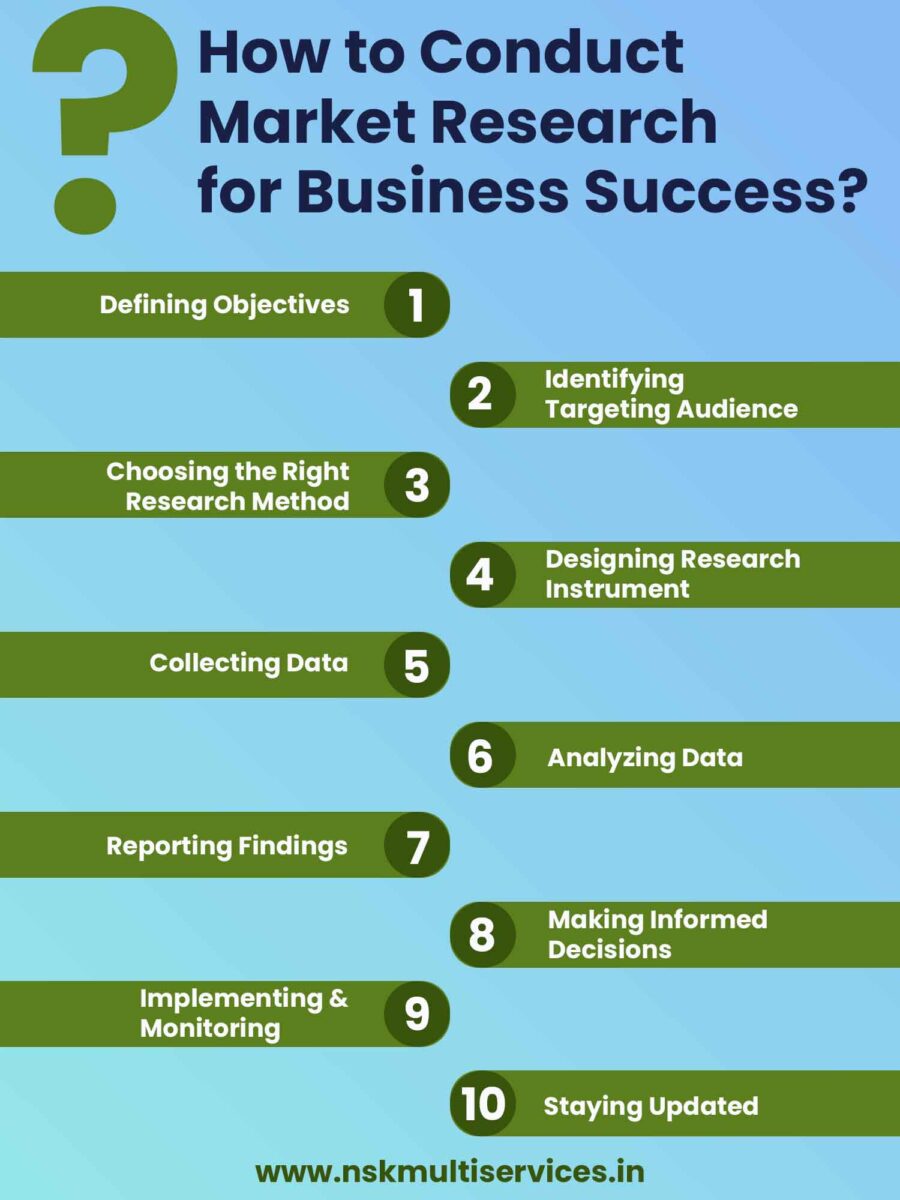How to Conduct Market Research for Business Success? - NSK MultiServices

How to Conduct Market Research for Business Success
In the dynamic world of business, understanding your target audience, competition, and industry trends is not a luxury but a necessity. Market research serves as the compass guiding your strategic decisions, product development, marketing efforts, and much more. Whether you’re a startup looking to carve your niche or an established business aiming to stay ahead, conducting effective market research is paramount.
1. Why Market Research Matters
Before delving into the how-to of market research, it’s essential to grasp why it matters so much for businesses of all sizes and industries. Market research offers several crucial benefits:
a. Informed Decision-Making
Market research provides the data and insights needed to make informed decisions. Whether you’re deciding on a new product line, entering a new market, or tweaking your marketing strategy, data-driven decisions are more likely to succeed.
b. Customer Understanding
Understanding your target audience’s needs, preferences, and pain points is essential for tailoring your products or services to their expectations. Market research helps you get into the minds of your customers.
c. Competitive Advantage
By analyzing your competition, you can identify gaps in the market and areas where you can outperform others. This can be a significant source of competitive advantage.
d. Risk Mitigation
Market research can uncover potential pitfalls and challenges, allowing you to proactively address them. It reduces the risk of launching products or strategies that are destined to fail.
2. Defining Your Research Objectives
Successful market research begins with a clear understanding of your objectives. What specific information are you seeking to gather, and how will it influence your business decisions? Common research objectives include:
- Assessing market demand for a new product or service.
- Identifying target audience demographics and psychographics.
- Evaluating customer satisfaction and feedback.
- Analyzing market trends and industry benchmarks.
- Measuring brand awareness and perception.
Your objectives should guide the entire research process, from data collection to analysis and implementation.
3. Identifying Your Target Audience
Your business exists to serve a specific audience, and market research helps you define and understand that audience better. This involves creating detailed customer personas that encompass:
- Demographics (age, gender, location, income).
- Psychographics (lifestyle, values, preferences).
- Behavior (buying habits, online activity).
- Pain points and challenges.
- Goals and aspirations.
The more detailed your customer personas, the better you can tailor your products, services, and marketing efforts to meet their needs.
4. Choosing the Right Research Method
Market research offers various methods, each suited to specific objectives and budgets. Here’s a closer look at some common research methods:
a. Surveys
Surveys involve creating questionnaires and distributing them to your target audience. Online surveys, email surveys, and in-person interviews are all viable options. Surveys are excellent for collecting quantitative data on a large scale.
When using surveys, ensure that your questions are clear, unbiased, and relevant to your research objectives. Consider using a mix of closed-ended (multiple choice) and open-ended (essay-style) questions for a comprehensive view.
b. Interviews
One-on-one interviews provide in-depth qualitative insights. Unlike surveys, interviews allow you to explore nuances, motivations, and opinions more thoroughly. It’s essential to build rapport with interviewees to encourage open and honest responses.
Interviews are particularly useful when you want to dig deep into specific topics, such as customer experiences, pain points, or feedback on a new product.
c. Focus Groups
Focus groups involve bringing together a small group of participants (typically 6-10 people) to discuss specific topics or products. A skilled moderator guides the discussion, encouraging participants to express their thoughts and opinions.
Focus groups are valuable for gathering diverse perspectives, particularly when developing new products or testing marketing concepts.
d. Observations
Observational research entails watching and recording customer behavior and interactions. This can be done in person (e.g., in-store observations) or online (e.g., tracking website user behavior). Observations can reveal insights that participants might not express in surveys or interviews.
e. Secondary Research
Secondary research involves using existing data, industry reports, and studies to gather information. It’s a cost-effective way to access a wealth of information without conducting primary research. Secondary sources include government publications, industry associations, and academic journals.
f. Competitor Analysis
Analyzing your competitors’ strategies, performance, and customer feedback can provide valuable insights. Tools like SWOT analysis (Strengths, Weaknesses, Opportunities, Threats) can help you assess your competitive landscape.
Choosing the right research method depends on your objectives, budget, and the type of data you need. In many cases, a combination of methods yields the most comprehensive insights.
5. Designing Your Research Instrument
Whichever research method you choose, it’s essential to design your research instrument carefully. For surveys and questionnaires, here are some best practices:
- Keep it user-friendly: Ensure that the survey or questionnaire is easy to understand and navigate. Use clear language and avoid jargon.
- Keep it concise: Respect your participants’ time by keeping the survey short and focused on the most critical questions.
- Avoid leading questions: Leading questions can bias responses. Frame questions in an unbiased, neutral manner.
- Test it: Before launching your survey or questionnaire, test it with a small group of participants to identify and resolve any issues.
6. Collecting Data
Executing your chosen research method involves careful planning and execution. Here are some tips for collecting high-quality data:
- Surveys: If using online surveys, choose a reputable survey platform that offers features like skip logic and response validation. Track responses and maintain participant confidentiality.
- Interviews: Prepare a list of open-ended questions and conduct interviews in a quiet, distraction-free environment. Record interviews with permission to ensure accuracy.
- Focus Groups: Schedule focus group sessions well in advance, and ensure participants are aware of the agenda. Facilitate discussions while recording responses and feedback.
- Observations: Whether in person or online, maintain detailed records of what you observe. Use tools like Google Analytics for online observations.
- Secondary Research: Carefully select secondary sources and ensure the credibility and relevance of the data.
- Competitor Analysis: Use tools like competitive analysis software to gather data on your competitors’ online presence, keywords, and customer reviews.
7. Analyzing Data
Once you’ve collected data, the next step is to analyze it systematically. The analysis phase involves:
- Organizing Data: Ensure all data is correctly organized for analysis. This may involve entering survey responses into a database or categorizing interview transcripts.
- Quantitative Analysis: Use statistical tools to analyze quantitative data. This can include calculating averages, percentages, correlations, and running statistical tests.
- Qualitative Analysis: For qualitative data (e.g., interview transcripts or open-ended survey responses), conduct thematic analysis to identify recurring themes and patterns.
- Visualization: Create charts, graphs, and visual representations of your data to facilitate understanding and decision-making.
- Interpreting Results: Translate your findings into actionable insights. What do the data reveal about your research objectives? How do these insights align with your business goals?
8. Reporting Findings
A well-structured report or presentation is crucial for conveying your research findings effectively. Here’s how to create a compelling research report:
- Executive Summary: Start with an executive summary that provides a concise overview of your research objectives, methods, and key findings.
- Methodology: Describe your research methods in detail. Explain how data was collected and analyzed.
- Data Presentation: Use visuals like charts, graphs, and tables to present data. Ensure that visuals are clear and labeled appropriately.
- Key Takeaways: Summarize the most critical findings and insights. What do these findings mean for your business?
- Recommendations: Based on your research, make recommendations for business decisions and strategies.
- Appendices: Include any supplementary materials, such as the full survey questionnaire, interview transcripts, or additional data.
9. Making Informed Decisions
With research findings in hand, it’s time to make informed decisions. The insights gained from your research should guide your business strategies, whether it’s product development, marketing campaigns, or customer service improvements.
10. Implementing and Monitoring
Implement the decisions made based on your research and continuously monitor their effectiveness. Market research is not a one-time effort; it’s an ongoing process to stay informed about evolving consumer preferences, industry trends, and competitive landscapes.
11. Staying Updated
Market research is a continuous endeavor. Customer preferences change, industries evolve, and competitors adapt. Regularly update your research to ensure your business remains agile and responsive to market dynamics.
Related Articles
- How to do Keyword Research for Google Ads
- Digital Growth Partner
- What is Online Reputation Management (ORM) in Digital Marketing
- Is Search Engine Submission Necessary?
- Service: Local SEO
Conclusion
Market research is the foundation upon which successful businesses are built. It’s not merely a task to check off a list; it’s an ongoing commitment to understanding your market, customers, and competition. When done right, market research empowers you to make data-driven decisions that can lead to sustainable growth and competitive advantage. So, embrace the research journey, and let it be your guiding light in the ever-changing business landscape.
About
Nandeshwar
Nandeshwar is a versatile professional skilled in digital marketing and App/Web development. With 5 years of experience and a Diploma in Computer Engineering, they excel in crafting effective marketing strategies and building dynamic websites. Specializing in content marketing, they drive results for clients while creating visually stunning websites using WordPress, Laravel, PHP and Flutter. Beyond work, they stay updated on industry trends and enjoy sharing insights.



